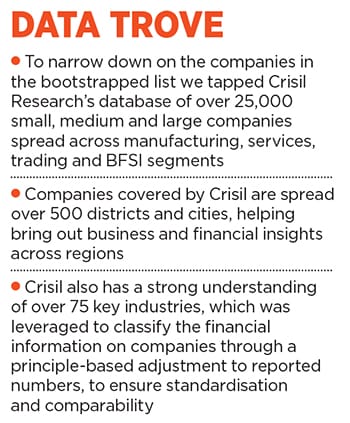
Why some businessmen choose to be masters of their own destiny
These bootstrapped businesses have focussed on their core products and geographical markets and have grown with the economy since liberalization

To be bootstrapped is the preferred choice of entrepreneurs the world over. Being self-funded helps lay a strong foundation for the business as the money at stake is almost entirely the promoter’s and, given the limited resources, there is a sharp focus on cost optimisation and cash generation.
This helps because external equity investors, if the founders ever choose to tread that path, like to see some success on the ground before committing large funds. It also helps in raising debt as lending by banks is typically security-based, making sizeable promoter equity a necessary precondition.

The opening up of the Indian economy in the early ’90s and the proliferation of the internet in the noughties, however, opened the floodgates to domestic and foreign capital. Many businesses adopted an aggressive growth path with capital raised from IPOs and private investors.
Yet, some others chose to remain bootstrapped and charted a steady growth path. A good 25 years since liberalisation, it is interesting to look at such companies and understand what drives them.
To search for genuine successes within the bootstrapped universe, we sifted through a database of over 25,000 small, medium and large companies based on certain criteria. Specifically, we looked at companies that have grown to a meaningful size (more than ₹500 crore in operating income, or turnover) in the past 25 years.
To ensure minimal dependence on debt, we focussed on companies with gearing ratios (proportion of a company’s debt to net worth) close to or less than one in the latest financial year for which data is available. In addition, we ensured they continued to scale despite reaching a large size.
We then checked the shareholding pattern of the shortlisted companies to narrow down to firms whose source of funding is the wealth of the promoters or their close families. Those funded by venture capitalists, private equity firms or well-established promoter groups were eliminated. We then reviewed their creditworthiness by looking at their rating history and outlook, which also helped us vet the background of the business. This group was then benchmarked with similar-sized companies, based on data available in the public domain. We also compared them with a high-growth peer set.
The resulting list, Forbes India’s inaugural Bootstrapped Bosses, is dominated by businesses that are consumption-related (houseware, garments), export-oriented or those linked to infrastructure-related spends—segments that have received a fillip in the past 25 years thanks to government policies.
Being self-funded helps lay a strong foundation. There is a sharp focus on cost optimisation and cash generation
By and large, these are mid-sized companies that focussed on their core products and geographical markets and have grown with the economy, capitalising on opportunities that came up.
Some promoters had a track record of managing their family businesses, but on a small scale. They corporatised at the right time and grew by recruiting professionals. Others were new-generation entrepreneurs who leveraged their strong work experience in established corporates.
CLICK HERE FOR MORE STORIES FROM THE 'BOOTSTRAPPED SPECIAL' SPECIAL REPORT
The shortlisted businesses are typically less capital-intensive and their promoters are judicious when using funds for capex and working capital. For example, capex has been incurred only for diversifications related to the core business, or for forward and backward integration, which also resulted in efficiency gains. Working capital is managed through strict control on inventories, distribution management and order-backed efficient procurement. Limited geographic diversification also plays a role in managing the inventory of infrastructure companies in the list.

These companies display an above-average financial profile, with median interest cover ratio—a measure of how easily a company can pay interest on outstanding debt—of 8x against 3x for peers and a debt-to-Ebitda (earnings before interest, taxes, depreciation and amortisation) of one against 2.5 for peers.
The group also displays superior return on capital employed (29 percent), which is over twice the rate of peers (13 percent). This holds true even when compared with the peer group containing only high growth rate companies.
Future Outlook
As businesses grow and opportunities in core products and geographies mature, the bootstrapped names in our shortlist would seek to expand beyond familiar territories gradually. How well they manage the risks of this phase and penetrate newer segments will decide their future performance.
The next generation’s philosophy on growth and risk appetite would also play a crucial role, while robust governance practices would become an imperative as their shareholder base widens.
Companies which began operations after India opened up had the advantage of riding the economic boom. But those starting now will face far stiffer competition, and may not have the choice of charting a path of steady growth with internally-generated capital.
(The writer is senior director and business head, Crisil Research)
CLICK HERE FOR MORE STORIES FROM THE 'BOOTSTRAPPED SPECIAL' SPECIAL REPORT
(This story appears in the 30 November, -0001 issue of Forbes India. To visit our Archives, click here.)
X




